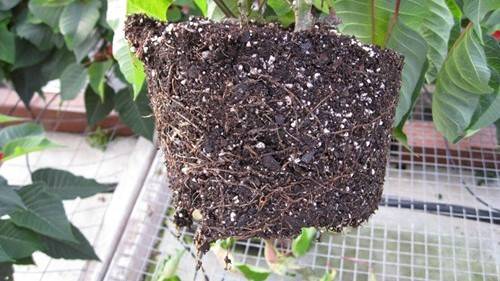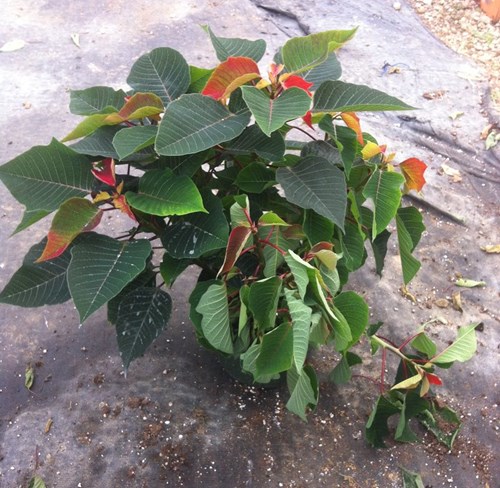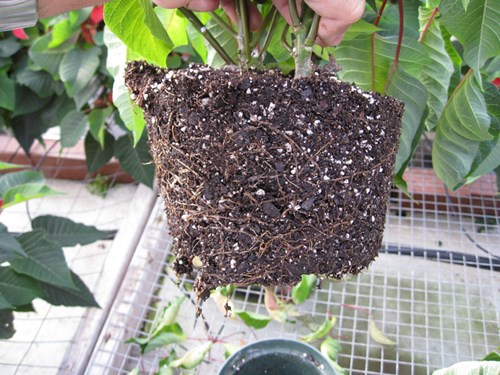Pythium Root Rot on Poinsettias


If you grow poinsettias, you probably have run into problems with root disease towards the end of the crop cycle. Many growers are aware that there is a connection between the cooler weather/shorter days and increased potential for root disease.
The most common root-rot pathogen that infects poinsettias late in the production cycle is Pythium. Here are the steps to identify and eliminate this root disease.
Pythium Species That Infect Poinsettias
Not all Pythium species are the same. Although there are many types of Pythium, the two main species that infect poinsettias are Pythium aphanidermatum and Pythium ultimum. Pythium aphanidermatum prefers growing medium temperatures above 77°F (25°C), so it can be an issue early in the crop cycle when temperatures are warm.
Pythium ultimum prefers colder growing media and has been found to cause the greatest amount of root damage at 62°F (17°C), but no serious root damage at 80°F (26°C). This species typically attacks poinsettias later in the crop cycle when both the outside temperature and growing medium are cold. What are the cultural conditions that exist during the cool, short days of the late fall that favour Pythium ultimum?


Moisture
Pythium acts more like a water mold than a fungus as it prefers wet growing media to survive and reproduce. In the late fall when the poinsettia crop is at the end of its production cycle, the days are getting shorter and temperatures are colder. Colder temperatures mean that the air holds less water, so it takes longer to dry the growing medium.
At the same time, the growth rate of a poinsettia slows during bract colouring, reducing water use by the crop. During most of the crop cycle when temperatures are warm and growth rates are rapid, overwatering is less of a concern. When outside temperatures cool, days shorten and plant growth slows, it is easy to overwater poinsettias unless the watering is adjusted. It is important to either pick up pots to determine how dry they are or look at the colour of the growing medium's surface. If it is light brown to tan or the pots are lightweight, then it is time to water.
Growing Medium
If the growing medium used has a high water holding capacity or has a lot of fine particles, it is easy to overwater when the days are short and cold. It is best to use a growing medium that has a higher air porosity to promote good air exchange with poinsettia roots. Another option is to use a growing medium that dries out rapidly between waterings.
AGTIV® REACH™ contains mycorrhizae, a natural fungus that helps acquire nutrients and water for poinsettias, improving overall plant health and making them less susceptible to environmental stress.
AGTIV® STIMULATE™ contains Bacillus, a natural bacterium that supports a healthy root environment, promoting plant establishment and vigour.
For a combination of both benefits, AGTIV® AMPLIFY™ offers both mycorrhizae and Bacillus, enhancing nutrient uptake, improving root development, and providing comprehensive support for plant health.
Air Temperature
Temperature can be an issue with Pythium. As seen above, P. ultimum prefers growing medium temperatures around 62°F (17°C). In late fall, temperatures in the greenhouse and the growing medium can become cold unless the grower maintains warm air temperatures. Compounding this problem is irrigating with cold irrigation water.
Cool air temperature and cold irrigation water drop growing medium temperatures, which favors P. ultimum. If possible, irrigate early in the day to try to maintain growing medium temperatures at or above 70°F (21°C) to help reduce problems with P. ultimum.
Fertility Rate and Salts
Poinsettias are considered heavy feeders, meaning they prefer high fertilizer application rates than other greenhouse crops. However, poinsettias use the greatest amount of fertilizer during rapid growth phases. Early in the crop cycle as the cuttings are rooting and getting established, poinsettias use little fertilizer. Constant feeding at 75-125 ppm nitrogen is best after rooting has begun and up to active growth.
Once poinsettias are actively growing, increase constant feed application rates to 200-250 ppm nitrogen. Once the bracts start to colour, growth slows down so fertilizer application rates should be reduced to 100-150 ppm nitrogen. If not, fertilizer salts begin to build up and damage tender roots. These damaged areas on plant roots serve as entry points for Pythium to grow into the root and infect the root system.
Even if feed rates are not high enough to cause root damage, higher fertilizer application rates produce soft growth which is susceptible to diseases, such as Pythium.
Growing Medium pH
Research has found that Pythium prefers a growing medium pH above 5.5. If the pH of the growing medium can be maintained at or slightly below 5.5, then Pythium is less likely to thrive. However, if the pH of the growing medium is too low, micronutrient toxicity could be a concern.
How to Correct a Pythium Problem in Poinsettias
Before correcting a root disease problem, it is best to have the diseased root system tested to verify which pathogen is causing the problem. This is important as chemical and biological control strategies vary depending on the type of disease.
If a poinsettia’s roots are infected with Pythium and the plant is wilting as a result of the disease, too much damage has been done to the root system and the plant should be discarded. However, if a poinsettia still looks healthy even though its roots have been infected with Pythium, there are cultural control measures that can help the plant recover.
Fertilizer salt levels
First, measure the fertilizer salt levels in the growing medium with an E.C. meter or have a sample of the growing medium sent off to a horticultural testing lab. If the salt levels in the growing medium exceed 3.5-4.0 mmhos/cm (using saturated media extract), then leaching is needed to flush out excess salts.
Dry the Growing Medium
Next, the growing medium must be allowed to dry between waterings. As stated, Pythium thrives in wet growing media, so allow the colour of the growing medium's surface to change to a light brown to tan colour between waterings.
This colour indication works well for peat-based growing media but is less effective for coir-based growing media. Also, lift the pot and check the weight to verify that the growing medium is dry. Roots that are kept constantly wet are under stress as they need oxygen to function properly to resist Pythium.
Growing Media Temperature
Check the temperature of the growing medium. If it is below 70°F (21°C), then warm the temperatures in the greenhouse to raise growing medium temperatures. This will encourage faster dry-down of the growing medium and root growth. Increasing airflow through the plant canopy by spacing poinsettias and turning on fans will help accelerate the dry-down of the growing medium.
New Roots
Once the growing medium environment has improved to favour poinsettia root growth, new roots will emerge and compensate for roots damaged by Pythium. These cultural changes along with chemical or biological fungicide drenches can prevent further crop damage. Depending on the amount of root damage, there may be some delay in finishing times for those poinsettias with greater Pythium infections, but most of the crop will finish at its scheduled time.
References:
- Peters, Cari and Ann Chase. 2008. Powerful Poinsettias. www.greenhousegrower.com. Aug 25, 2008.
- Beckerman, Janna. 2011. Disease Management Strategies – Pythium Root Rot of Herbaceous Plants, BP-181-W. www.btny.purdue.edu. Jan 2011.
- Moorman, Gary. Plant Disease – Pythium, Penn State Extension. http://extension.psu.edu/pests/plant-diseases/all-fact-sheets/pythium
- Smith, Tina and Angie Madeiras. 2015. Pythium Root Rot on Poinsettias. https://negreenhouseupdate.info/updates/pythium-root-rot-poinsettias. Nov 13, 2015